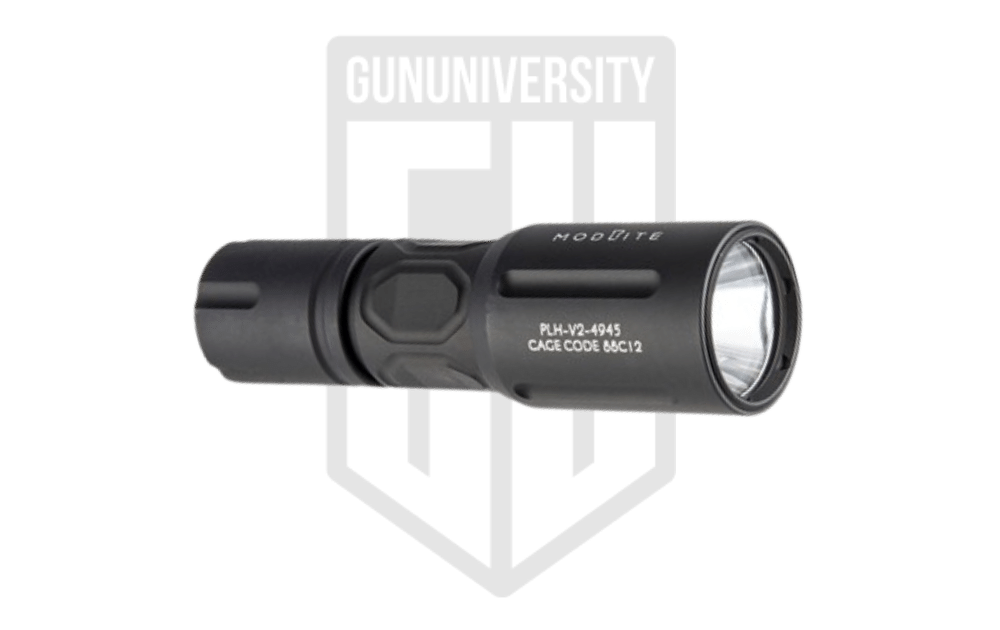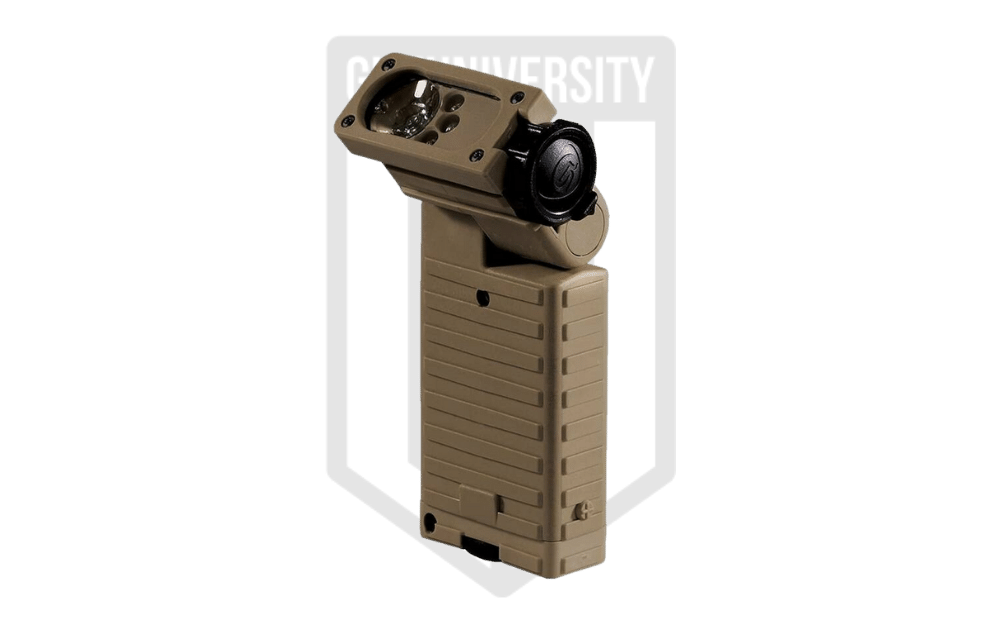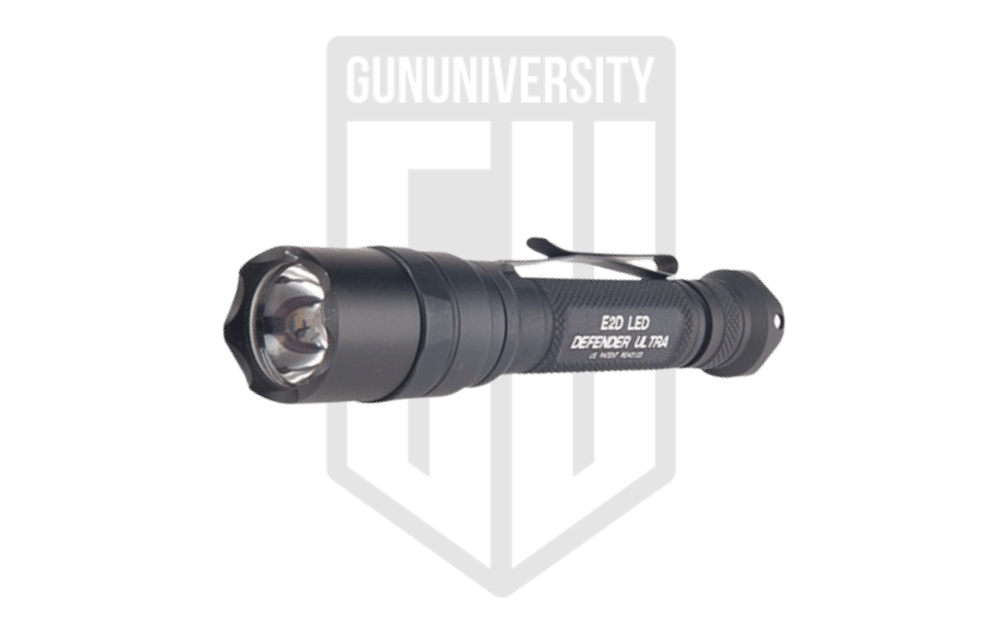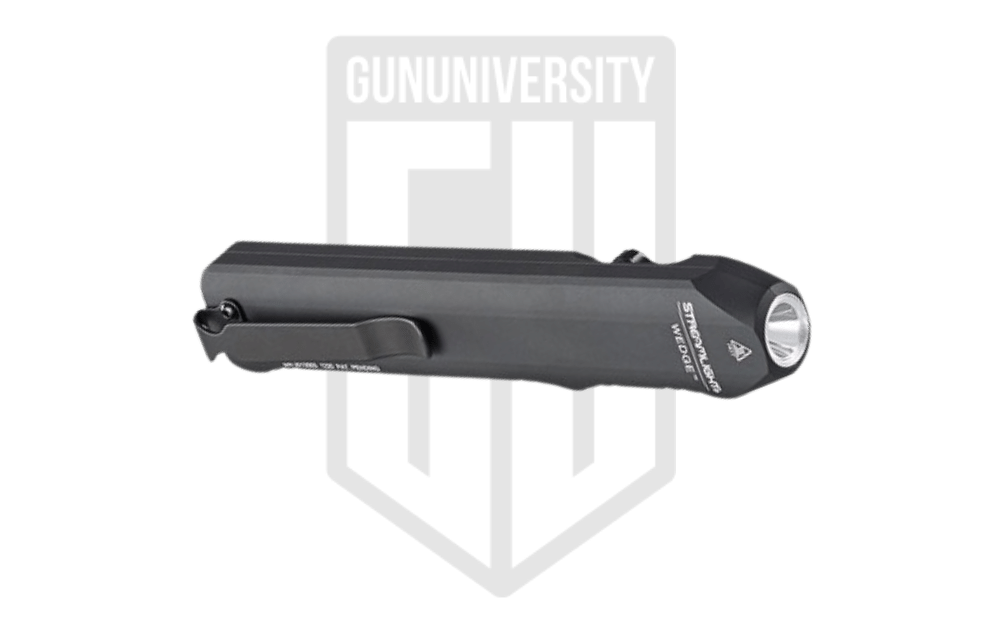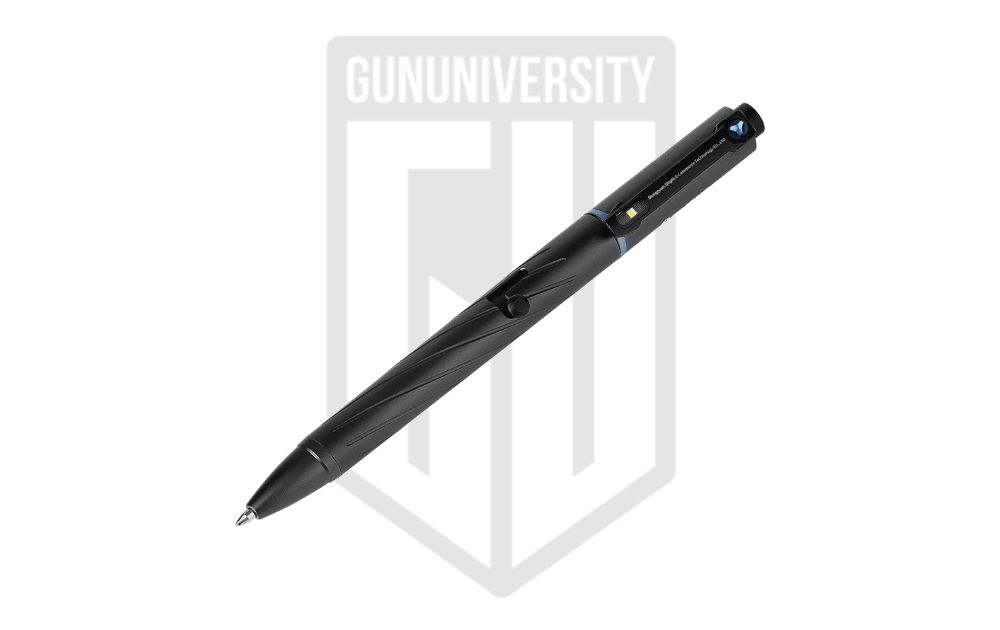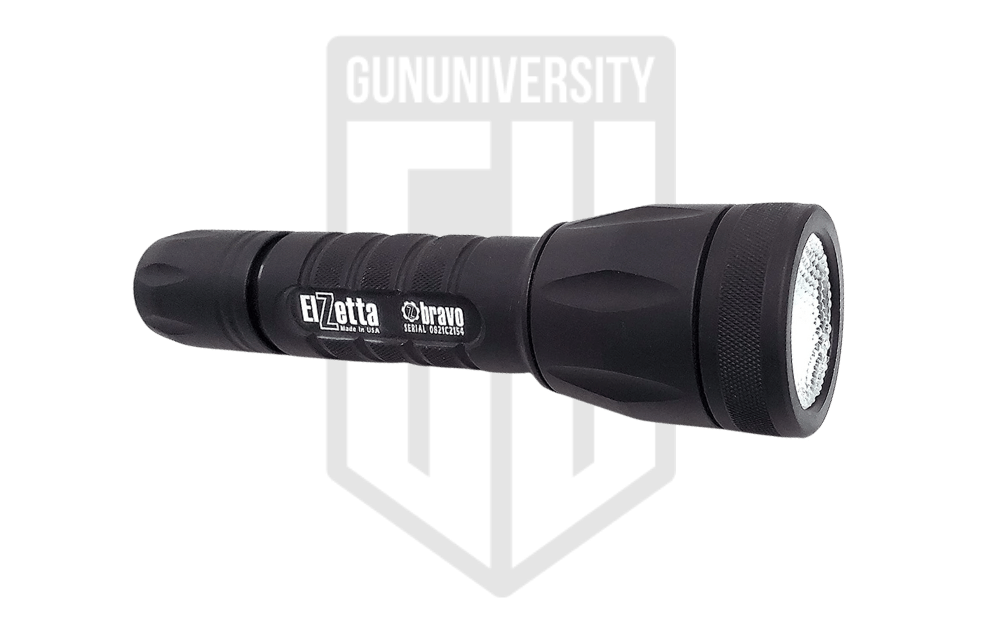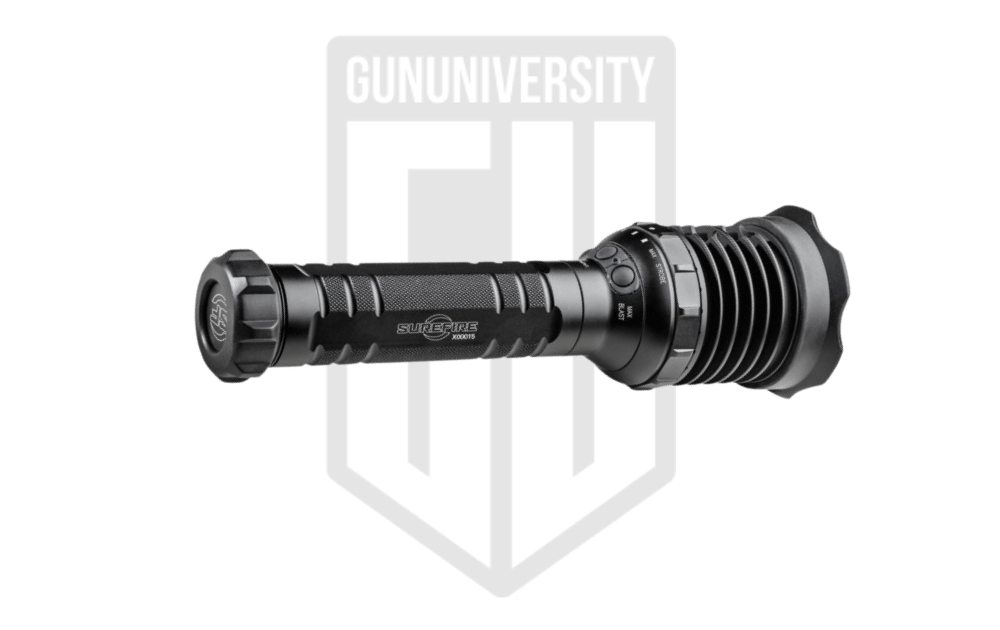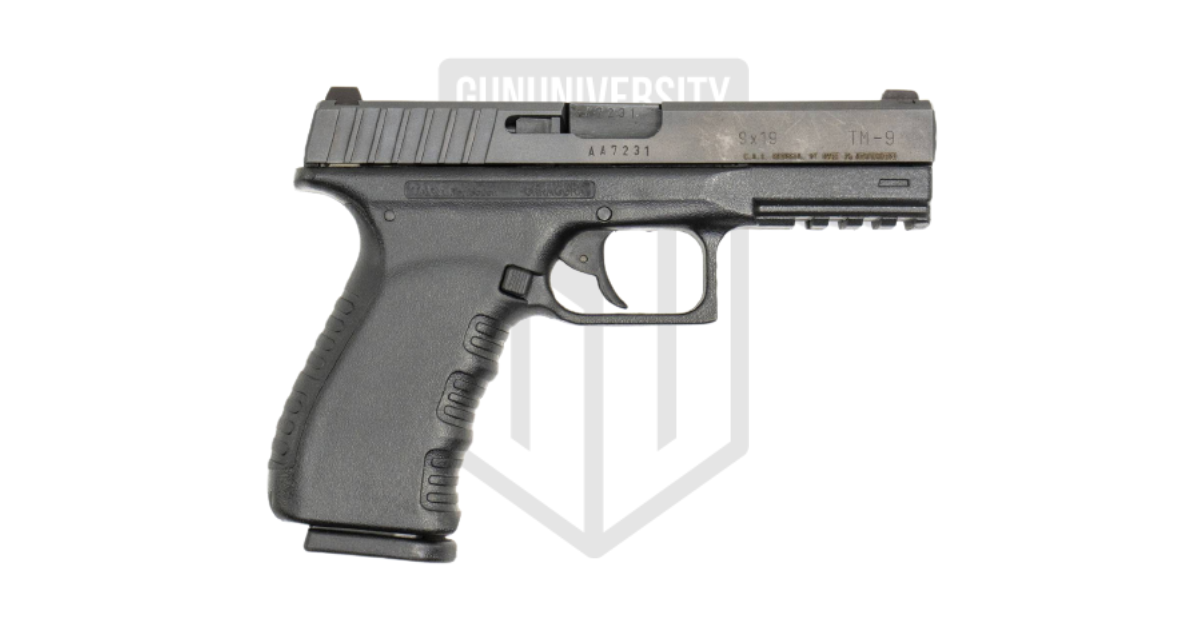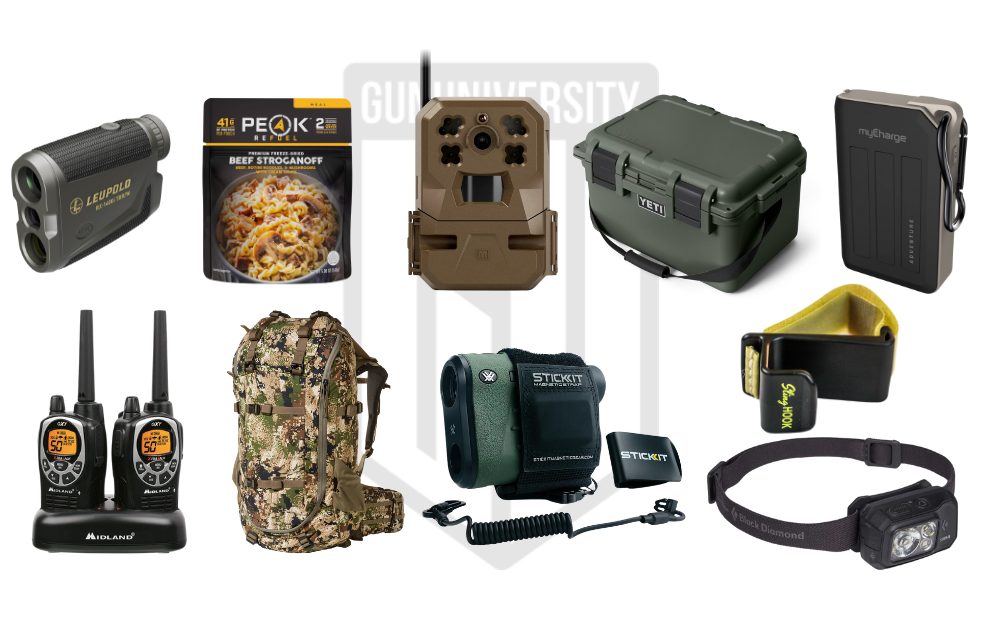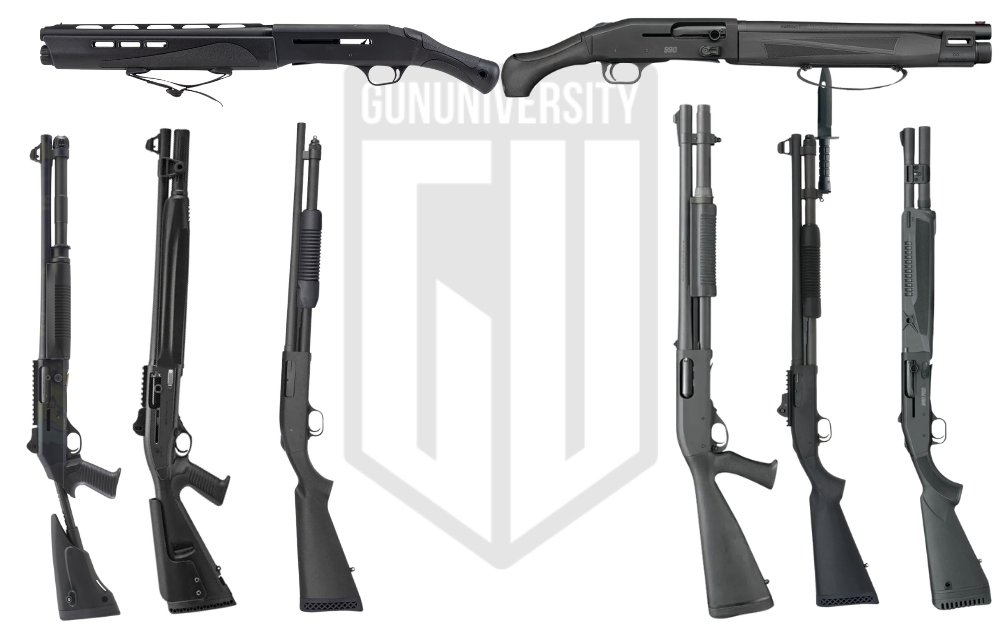7 Best Tactical Flashlight Choices : Gun University
If you paint it black and stylize it, you can call it tactical it would seem. Tactical gets thrown around a lot these days, and as such, it’s easy to roll your eyes at it. One series of tactical doodads and gadgets that shouldn’t be ignored is tactical flashlights. Tactical flashlights are most certainly a distinct and separate category of flashlights. They respond to significant demand in critical situations and are widely utilized by police, military, and first responders for a reason.
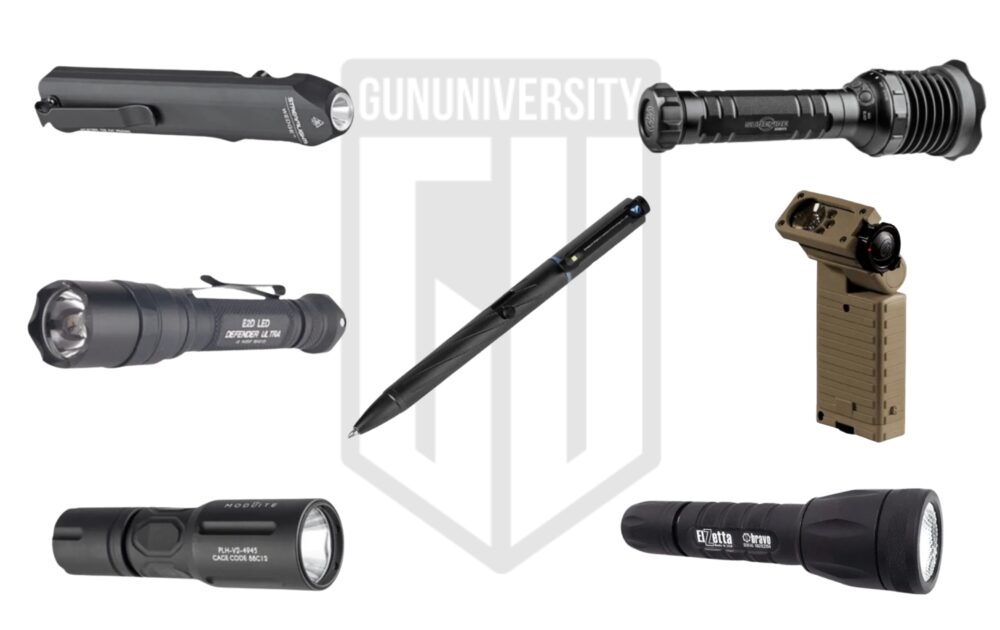
What Makes a Light Tactical?
Coming up with one set of descriptors for a tactical light is impossible. Different scenarios require different functions and features. The features a cop wants will be different than the features a soldier or firefighter wants. It’s tough to say what is and what’s not a must-have for a tactical light. In my opinion, the only real requirement is that the light be durable and well made.
Individual task, purpose, and use will dictate the features required of a tactical flashlight. The typical uses of a tactical flashlight can be broken down into a few categories.
The Tactical Light Role
EDC – EDC stands for everyday carry and encapsulates the civilian concealed carrier or off-duty cop, soldier, first responder, etc. EDC refers to the gear you carry day in and day out, from your gun to your light to your knife. Everyday carry lights are often required to be pocketable and easy to carry.
They don’t require the same power as a duty light and therefore can be smaller and still acceptable. These lights range from 300 to 600 lumens on average and offer a good mixture of power and battery life. They should be reasonably durable but don’t need to be weapon-grade.
Duty Use – Duty use lights often prioritize power and durability over size and battery constraints. They often want to maximize lumens and candela to provide an extremely capable and powerful light. Duty lights may need to see further, through smoke and fog as well as photonic barriers created by light. This requires power, lots and lots of power.
Since these lights are often involved in the rough world of police work, firefighting, and soldiering, they should be durable and well made. Being able to withstand shock and be waterproof are only the beginning for lights like these. Duty use lights often have the most demanding needs and uses.
Emergency Use / Outdoor Adventures – Packing a bug-out bag, a hurricane kit, or assembling a vehicle emergency kit requires a good flashlight. These emergency use lights are what I often call long-life lights. They are of moderate low power with outputs rarely above a hundred lumens or so. These lights are for navigating dark houses, cars, shelters, or changing tires in the dark, not for finding hiding, bad guys. They are designed to last for hours at a time and be used over a multitude of days.
Alternatively, these same lights serve hikers, campers, hunters, and other outdoor adventurers well. They provide enough light to accomplish basic tasks and provide a long-lasting battery life. They can be handheld or headlamps. It’s best to have some means of using the light for hand’s free purposes.
These lights should be drop-proof and water-resistant, but beyond that, they don’t need to be Navy SEAL approved.
How I Chose the Best Tactical Flashlight
As a seasoned shooter who regularly participates in NRL22 and IPSC, I’ve had the opportunity to use a wide variety of tactical flashlights, which has given me a good understanding of what makes a quality flashlight.
To make this list fair, I didn’t just rely on my own experiences. I also asked my friends who are fellow competitive shooters to help me out. By combining their knowledge with mine, I’ve made this list of the best tactical flashlights for different applications.
I understand that choosing a tactical flashlight is a personal decision, and what works for me may not be the perfect fit for you. Everyone has their unique preferences. That’s why, even though I’ve ranked these flashlights from 1 to 7, I’ve ensured that the selection caters to a diverse range of needs. I’ve also included a buyer’s guide to assist you in knowing what to look for when you’re in the market for a tactical flashlight. So, let’s dive in!
Best Tactical Flashlights
- Modlite PLHv2 Handheld
- Streamlight Sidewinder
- Surefire E2D Defender Ultra
- Streamlight Wedge
- Olight OPen 2
- Elzetta Bravo
- Surefire UDR Dominator
Best Tactical Flashlights
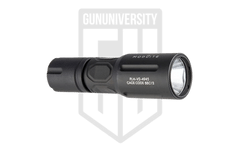 | Editor’s Pick
| Check Price | |
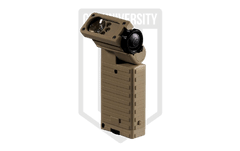 | The Adventure Light
| Check Price | |
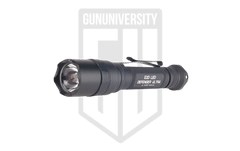 | Duty/EDC Hybrid
| Check Price | |
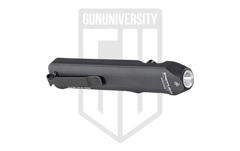 | The EDC Option
| Check Price | |
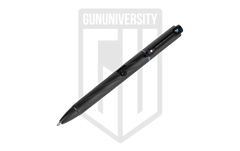 | Minimalist EDC Option
| Check Price | |
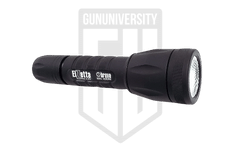 | Build Your Own
| Check Price | |
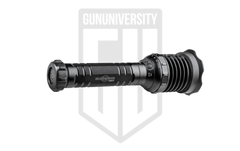 | An Absolute Beast
| Check Price |
Tactical Flashlights Specs
Below we have lined up our top picks for Best Tactical Flashlights so we can have a close look at their individual specs.
| Flash Lights | Lumens | Candela | Batteries |
|---|---|---|---|
| Modlite PLHv2 Handheld | 1350 | 54,000 | 18650 Rechargeable |
| Streamlight Sidewinder | 55 | 1,175 | AA |
| Surefire E2D Defender Ultra | 1,000 | 10,500 | 2x 123a |
| Streamlight Wedge | 300 Main THRO 1,000 | 1200 / 3000 | Internal Rechargeable |
| Olight OPen 2 | 5, 20, 60, 120 | 64 | Internal Rechargeable |
| Elzetta Bravo | 850 lumens | 12,000 | 2x CR123a |
| Surefire UDR Dominator | 2,400 | 200,000 | 12x CR123a |
Best Tactical Flashlights
Below we’re breakdown our top choices for Best Tactical Flashlight and look at their individual specs and reviews.
Modlite PLHv2 Specs
- Lumens 1350
- Candela 54,000
- Batteries 18650 Rechargeable
Modlite PLHv2 Handheld – Editors Choice
The Modlite PLHv2 provides a combination of 1,350 lumens combined with 54,000 candela to provide one of the most powerful lights on the market. Sure, there are lights that are more powerful, but they are often a foot long. The Modlite PLHv2 gives users an incredibly powerful light that shines extremely far and works as a spotlight.
It’s a perfect duty light, and in that role, it’s quite compact. It’s not pocketable but still easy to tote on-duty gear. The PLHv2 provides users a very durable design that can be dropped, kicked, and soaked with water, and it’ll still function beyond a shadow of a doubt.
Modlite PLHv2 Handheld Pros and Cons
- Extremely powerful
- Efficient in size
- Durable
- Expensive
Modlite PLHv2 Handheld Deals
-
$309.00
-
$309.00
Streamlight Sidewinder Specs
- Lumens 55
- Candela 1,175
- Batteries AA
Streamlight Sidewinder – The Adventure Light
I carried a Streamlight Sidewinder for five years as a Marine. It’s been to a dozen different countries in my pocket or in a pouch. It’s a simple light with a square design that incorporates a rotatable head. The square design allows it to be placed on the ground and the light cast wherever you need it. The little Sidewinder isn’t an ultra-powerful light packing a high white light of a mere 55 lumens.
Battery life goes up to 200 hours, making it perfect for adventuring or as an emergency light. It’s super simple but very effective and incredibly durable. The Sidewinder comes with white, red, blue, and IR beams opening up the versatility of the light.
Streamlight Sidewinder Pros and Cons
- Affordable
- Versatile
- Durable
- Low powered
Streamlight Sidewinder Deals
-
$61.89
Surefire E2D Defender Ultra Specs
- Lumens 1,000
- Candela 10,500
- Batteries 2x 123a
Surefire E2D Defender Ultra Review
When you want a light powerful enough for duty but small enough for EDC carry, the Surefire E2D Defender Ultra packs a punch. It’s slightly big for EDC, but it can work. The Surefire E2D is loaded with 1,000 lumens and over 10K candela. It provides a good deal of light for both indoor and outdoor use. Surefire is the go-to brand for duty lights by both police and military units due to their power and durability.
These are bomb-proof lights, and the Surefire brand has been the most tested light in the world. The all-metal design allows you to turn a powerful light into an impact weapon if need be. The Surefire E2D Defender Ultra comes with an optional 5-lumen mode for admin tasks and allows the preservation of battery life. It’s a very capable light from a well-proven brand.
Surefire E2D Defender Ultra Pros and Cons
- Powerful
- Extremely Durable
- Versatile size and power ration
- Expensive
Surefire E2D Defender Ultra Deals
-
$197.00
-
$197.00
-
$159.99
Streamlight Wedge Specs
- Lumens 300 Main THRO 1,000
- Candela 1200 / 3000
- Batteries Internal Rechargeable
Streamlight Wedge – The EDC Option
The Streamlight Wedge is a brand new light but has quickly become my personal favorite EDC light. Its small size and convenient shape make it extremely handy for pocket carry and ensures it’s easy to carry with one hand or even in the mouth. The light boasts 300 lumens in normal mode with optional THRO mode that increases the lumens to 1,000 and the candela to 3,000 for 35 seconds.
The USB-C charger makes it convenient to charge beside your cell phone and to share the most common USB charging devices. It’s quite lightweight and fits the pocket perfectly. The Wedge is a unique design that works for daily carry and fulfills my need for a convenient and powerful enough light for most tasks.
Streamlight Wedge Pros and Cons
- Unique Ergonomic Design
- Optional THRO mode is handy
- Pocket Friendly
- Can’t hot-swap batteries
Streamlight Wedge Deals
-
$96.99
-
$99.99
Olight OPen 2
- Lumens 5, 20, 60, 120
- Candela 64
- Batteries Internal Rechargeable
Olight OPen 2 – Minimalist EDC Option
I’m not going to lie, I typically don’t care for Flights, but the OPen 2 is one of the few I appreciate. It’s an ultra-convenient tactical pen made completely from aluminum and powered by an internal rechargeable battery. It has multiple modes that include 5, 20, 60, and 120-lumen modes for various runtimes.
The light can be removed from the pen and still function, making it easy to write and see what you’re writing. The candela doesn’t provide much range but powers enough to light up a small room and makes it easy to always pack an EDC light. It’s extremely small, easy to wield, and very easy to carry. It’s not a powerful light but provides a minimalist option for those needing a light.
Olight OPen 2 Pros and Cons
- Ultra Easy to Carry
- Multiple Modes
- Doubles as a Pen
- Weak range
Olight OPen 2 Deals
Elzetta Bravo Specs
- Lumens 850
- Candela 12,000
- Batteries 2x CR123a
Elzetta Bravo – Build Your Own
If you want to build the light of your dreams, the Elzetta Bravo lets you select the components you want for the light you want. This includes a spotlight or floodlight head, multiple tail caps, all built on the Bravo body style. The Elzetta Bravo is a powerful light that packs 850 lumens backed by over 12k candela.
The Elzetta Bravo provides an extremely durable light from a very underrated company. Shooters get a very powerful handheld light that’s easily convertible to a weapon light with the swap of a tail switch and the addition of a mount. It’s perfect for users who want to customize and build their own light.
Elzetta Bravo Pros and Cons
- Build Your Own
- Powerful
- TIR beam provides awesome image quality
- Expensive
Elzetta Bravo Deals
Surefire UDR Dominator Specs
- Lumens 2,400
- Candela 200,000
- Batteries 12 CR123A’s
Surefire UDR Dominator – An Absolute Beast
With 200,000 candela, this flashlight is like a handheld spotlight, delivering an incredible amount of power. It’s purely a duty-use flashlight and one of the brightest tactical flashlights available, making it ideal for finding suspects in the dark and for search and rescue missions.
This beefy beast weighs 38.4 ounces and is almost a foot long. It’s a Maglite of power on steroids. As such, it’s not an EDC light by any means. The Surefire Dominator is an absolute beast and comes with a rather beastly price tag too.
Dominator is the appropriate term for this light. This massive light carries a ton of power, including over 200,000 candela. This makes this thing a veritable handheld spotlight that wields an absurd amount of power. It’s purely a duty-use flashlight that’s an excellent tool for finding suspects in the dark and for search and rescue operations.
Surefire UDR Dominator Pros and Cons
- Absurdly
- Large, but efficient in its size
- Hour Run Time
- Superbly Expensive
Surefire UDR Dominator Deals
-
$1,233.00
-
$1,233.00
-
$1,233.00
Tactical Light Considerations – Buyers Guide
Let us look into some specifics when it comes to flashlights and what to look for. What I look at is the construction, ergonomics, and the beam.
Construction
When it comes to tactical lights, the construction should be made up of a high-impact material that can take a hit. Metal is obviously the preferable option, especially for duty lights. These lights can be used as weapons, used in rough environments, and potentially be exposed to chemicals, heat, and more in their duties. Metal construction ensures they can take the abuse applied to them.
Beyond that, high-impact polymers can often be a good alternative. These are perfectly acceptable for emergency use and EDC lights. Modern polymers can be rather tough and make the light just as easy to seal from the elements as metal. Polymers can reduce weight and the price tag of a light.
Besides the material, it’s wise to look at how the light is sealed. Does it use o-rings or rubber seals at connection points? These rubber seals help keep moisture and debris out and will add a layer of protection to the batteries and internals.
I also prefer a lens that is set into the bezel. The bezel is the front-most portion of the light. A set-in lens means the lens is protected from drops and damage. Lenses are often glass or plastic, and that provides an easily breakable medium.
Ergonomics
Another consideration is the light’s ergonomics. Ergonomics encapsulate the light’s weight and length as well as its controls and external shape and texture. For tactical lights of all types, you typically want some form of texturing to keep the light in your hand when wearing regular gloves or combat gloves, have wet hands, and similar grip-threatening conditions.
Generally, the bigger the light, the more power you’re expecting from it. The old school massive Mag Lites don’t deliver near as much power as they should and are rather inefficient. Size matters a good bit for EDC use.
You typically need to fit the light in your pocket. It matters a little less for duty reasons, but you’ll still want a light that fits on your belt and doesn’t pull your belt down or get in the way. If the light is over sized, it should provide a brutal amount of light for specialized purposes.
When it comes to controls, the rear tail cap is easily the most popular option. These rear ‘clicky’ tail caps provide a simple and very durable means to control the light. This control method is extremely common on tactical lights because it makes the light easy to use when wielding a handgun.
Regardless of the controls, they should be simple to use and easy to use in the dark. They should provide good tactical feedback, and if they offer different settings, they should be relatively easy to access. A flashlight shouldn’t require you to memorize an instruction manual to use it efficiently.
The Beam
Flashlight beams come in roughly two different types and a hybrid of the two main types. The two main types include spotlight and floodlight.
Spotlight – Spotlights focus the beam and push it further. These lights offer the most range possible. These work well for objectives that require a powerful beam for not only range but for defeating smoke, fog, photonic barriers, and the like.
Floodlights – Floodlights cast a wide beam with limited range and typically fill your vision. They make searching close quarters environments easier. They offer perfect peripheral vision and make doing admin tasks a bit more simplistic.
Temperature
Beams have varying temperatures that range from cold to warm. This might sound confusing, but the temperature is less about the actual measurable temperature of the light and more about the color. It’s a spectrum but on each side sits cool and warm.
Warm – Warm beams appear more yellow than any other color. These lights make it easy to see true colors and typically do well against photonic barriers when backed by a high level of lumens and candela.
Cool – Cool white beams deliver light that’s more white and blue than yellow. Typically these cooler colors are easier on the eyes of the wielder than harsh yellow light. It also tends to provide a brighter hotspot at range.
Lumens and Candela
Lumens are the classic marketing talk to tell people how powerful your light is. Sadly, it works, but the truth is lumens mean nothing without candela. Whenever I look at a light, I look for candela and lumens to gauge its actual power.
Lumens are a measure of the raw power of a light. Sure 1,000 lumens is bright, but it means nothing when it’s not backed by candela. Candela takes that raw power and focuses it. A focused light provides range and strengthens the beam to defeat barriers created by fog, light, and smoke.
Combine high lumens with high candela, and you get a bright and powerful light. Combine high candela with low lumens, and you get a long-range, low-powered light. Combine high lumens with low candela, and you get a brighter light with hardly any range to it.
Don’t buy into the marketing hype of just lumens. A 600 lumen Olight Mini Valkyrie 2 offers a less effective range than my Streamlight 300 lumen ProTac because of the candela difference.
Light Modes
There are various modes a tactical flashlight can offer the user, and it’s smart to pay attention to the modes when choosing a light. It’s even smarter to understand the various modes.
Constant – Just on. Normal operation means the light comes on when activated and turns off when deactivated.
Momentary – Momentary mode activates the light when the button is pressed and automatically shuts off when the button is released—often used to maintain light discipline.
Turbo – A Turbo mode is any mode where the light output is temporarily heightened. This temporary mode allows for a higher lumen output for specific tasks.
Strobe – Strobe modes quickly flash the beam at an intense level. The idea is to disorient a potential threat.
SOS – SOS mode slowly but automatically blinks the light to signal for emergency help.
Battery Type
Tactical flashlights use all sorts of different batteries, and generally, you’ll see lights using CR123s, Double As, Triple As, and more. That’s not the battery type we are talking about, and we are focusing mostly on disposable or rechargeable.
Disposable batteries are great for logistics. You can easily swap them out when they die and keep going. They’re affordable, widely available, and quick to replace. Some rechargeable flashlights also allow hot-swapping, letting you quickly plug in a newly charged battery for uninterrupted use.
For duty lights, I want the capability to hot-swap batteries on the fly regardless of their type. In the United States, hot-swapping rechargeable batteries is easy but overseas can prove problematic. My first deployment didn’t provide me accessible power to recharge a battery, so disposable was the only realistic option.
When choosing lights with rechargeable batteries, choose commonly found rechargeable batteries like the 18650. This way, replacements can be easily purchased. Stay away from anything with the phrase proprietary battery.
Lights designed for emergency purposes might also be better suited with disposable batteries. Long-term power outages make it tough to charge rechargeable batteries.
Permanent rechargeable batteries aren’t lights I’d typically trust for duty or emergency use. For EDC, they are perfectly fine. You can charge them at night or in your car and always be ready for day-to-day use.
The fourth type of flashlight is known as dual fuel. Dual fuel lights allow you to use both removable rechargeable batteries and disposable batteries. These are the best of both worlds, in my opinion.
The Light Side
Tactical flashlights range everywhere from pocket-friendly EDC lights to massive spotlights designed for crew-served firearms. They come in all shapes and sizes, and I guarantee there is one out there for you. Just keep the above in mind when shopping and you’re bound to find the right option for you.
Best Tactical Flashlight – FAQs
What should I look for in a tactical flashlight?
When you’re searching for a reliable tactical flashlight, go for one that’s built tough, like those made from aluminum or other sturdy metals. It should be able to handle water and shocks without failing. Consistent performance is key, so check for a reliable switch mechanism and long battery life. It’s also a good idea to look at user reviews to see how the flashlight holds up in real-world use.
How do I choose the brightest tactical flashlight?
If you’re after the brightest tactical flashlight, check the lumens rating – the higher, the brighter. But don’t just stop there. Look at the beam distance and intensity (candela) too, because a focused beam can be more effective in certain situations. Reading user reviews and professional tests can help you find out which models really shine the brightest.
What is the best light source for a tactical flashlight?
For tactical flashlights, LEDs (Light Emitting Diodes) are the way to go. They’re super efficient, last a long time, and produce a really bright light. Plus, LEDs are tough and can take a beating, which is great for tactical use. They come in different color temperatures and beam patterns, so you can pick one that suits your needs.
What type of battery is best for a tactical flashlight?
The best battery type depends on how you plan to use your flashlight. Rechargeable batteries, like the 18650 or built-in rechargeable options, are great if you use your flashlight a lot because they’re cost-effective and convenient. On the other hand, disposable batteries, like CR123A, are handy for situations where you can’t recharge, such as long outdoor trips or deployments.
Can tactical flashlights be used as a self-defense tool?
Absolutely, tactical flashlights can be a handy self-defense tool. Many come with a crenellated bezel, which can be used to strike an attacker. The super bright light can also temporarily blind or disorient someone, giving you a chance to escape.
Recent Posts
December 8, 2025
November 29, 2025
November 25, 2025
November 22, 2025

